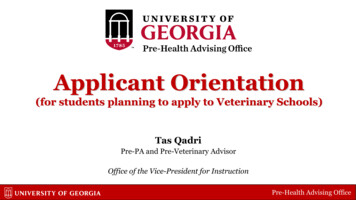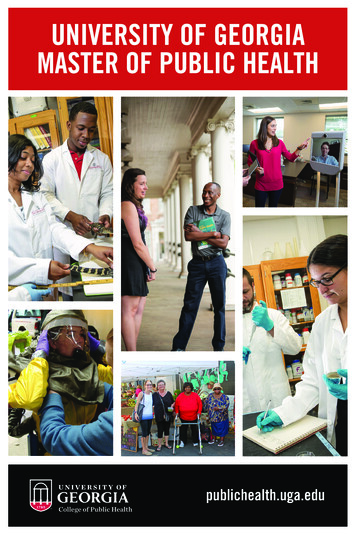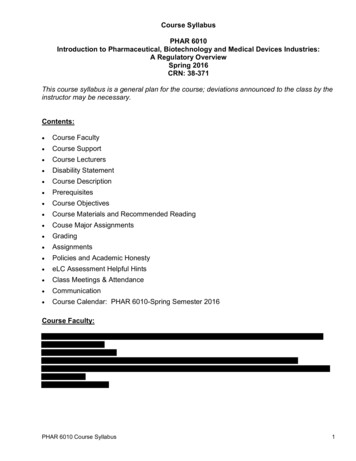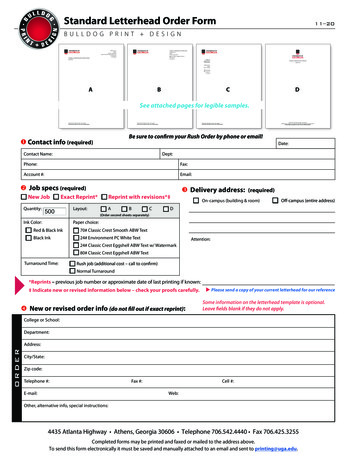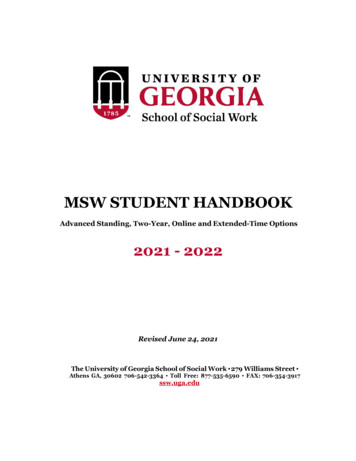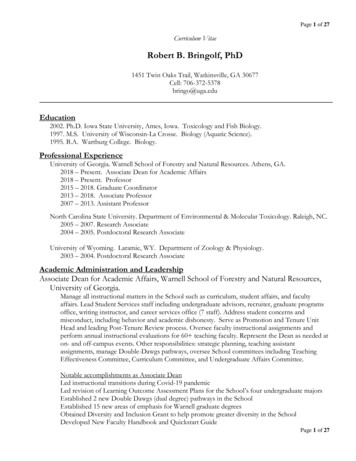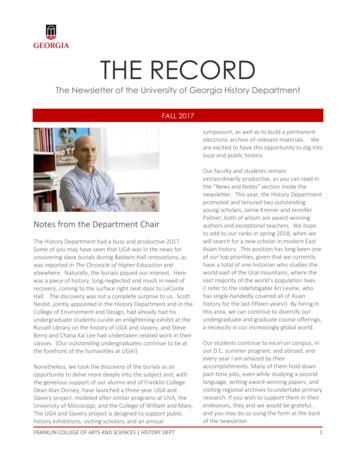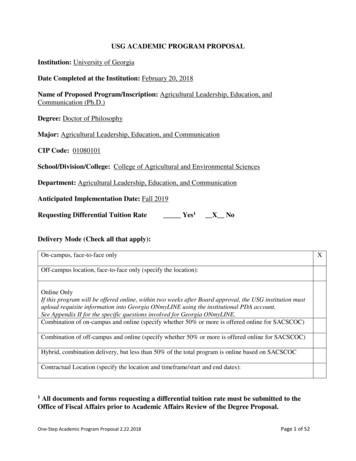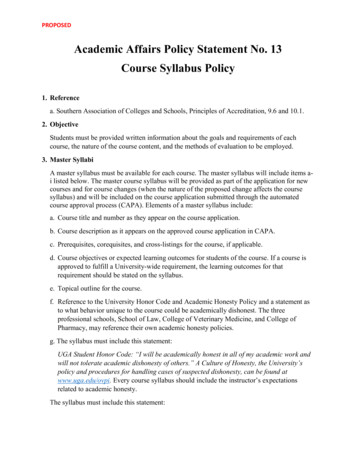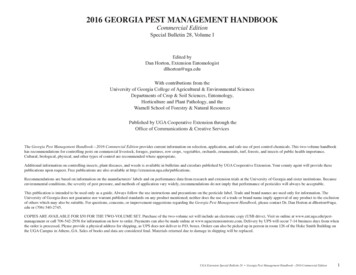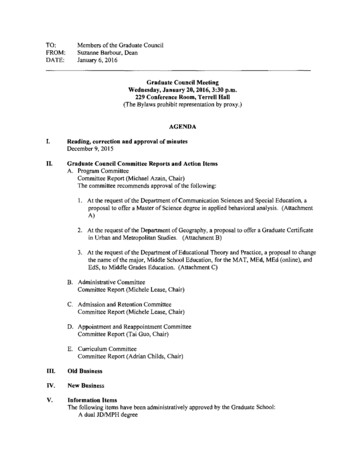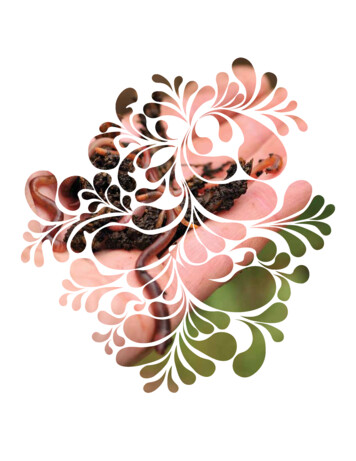
Transcription
Lesson 2Nutrients We NeedOBJECTIVESTo emphasize the similarities between humans and plants in the need for nutrientsTo learn about the six classes of nutrients and why we need all six of themTo learn how to identify good food sources of selected nutrientsTo learn how plants provide us with nutrientsTo learn about replenishing the nutrients in soil through vermicomposting(composting with worms)APPLICABLE CONTENT STANDARDSEnglish–language artsScience(See the matrix in Appendix B.)Materials for In-class Lesson andActivitiesMaterials for Gardening ActivityHandouts:Handouts:2-1 Nutrient Sandwich2-2 Nutrient Word Search2-3 My Friend, the WormMaterials for one worm bottle:“10 tips”2-liter plastic soda bottleNutrient Sandwich overhead transparency(if desired)Moist, shredded newspaper (black and whiteonly, no color)Shredded lettuce (Ask the cafeteria staff for leftover lettuce without dressing on it.)Half-pint of red worms (Contains approximately50 worms, enough for five bottles. See “Background Information” for ordering information.)A 4- to 5-inch square piece of dark material, suchas a cotton sheetRubber bandBlack construction paperSpray bottle filled with waterTapePurchased or finished compost (for gardenpreparation, time permitting)Lesson 2: Nutrients We Need29
Preparation for In-class Lessonand ActivitiesPreparation for Gardening ActivityDay before the lesson:Day before the lesson:Photocopy handouts 2-1, 2-2, and the “10 tips.”Photocopy handout 2-3.Make an overhead transparency of the nutrientsandwich (if desired).Gather materials.Gather materials.Prepare 2-liter soda bottle (see step 1 under“Gardening Activity”)Just before the lesson:Just before the lesson:Have students take out nutrition folders.Moisten the paper for the worm bottles.Nutrition Lesson Activities(60 min.)1. Review of Lesson 1Who remembers what our bodies need in order to grow, stay healthy, learn in school, and play?Food, water, air, exercise, and sleep (Remember the game of charades?)In addition, remember that most of our foods come from plants and animals.2. Nutrient discussion. Distribute to each student the Nutrient Sandwichhandout (2-1).Food provides our bodies with many different nutrients. Does anyone know what a “nutrient”is? Has anyone seen the list of nutrients on the food labels? Nutrients are substances that ourbodies need to help us do all the things that we do every day. They give our bodies energy,help us grow, and keep us healthy. There are six different classes of nutrients.Our bodies need all six types of nutrients, which can be found in many different foods.Now look at all six nutrients. Learn what the different classes are, what the nutrients do, howa plant gets them, and where they may be found on the “nutrient sandwich.” Go through eachof the nutrients on the Nutrient Table on page 34.a. Have one student read aloud from the handout (2-1) the information about one nutrient.b. Mention to the students the food associated with each nutrient. Where would you find thenutrient on the nutrient sandwich? (There may be more than one food per nutrient.) Draw aline connecting the nutrient to the correct part of the sandwich. Follow along on the overhead transparency if desired.c. Have the class do the activity in the last column on the handout.d. Repeat for each nutrient.Have students repeat the names of all six nutrients before moving on to the next section.(They make great spelling words!)30Nutrition to Grow On
3. Plants and nutrientsWe eat plants to get nutrients so we can grow and stay healthy. Why do the plants neednutrients? How do they get those nutrients?Carbohydrates. Made in the leaves through the process of photosynthesis. Carbohydratesinclude the sugar that the plant makes and uses for food; they are also a source of energyfor plants.Minerals. Taken up from the soil by the roots. Plants need minerals to grow.Protein and fat. Nutrients manufactured by plants. Plants make only what they need.Vitamins. Made by the plant by using carbohydrates, water, minerals, and sunlight.Water. Brought up to the plant through the roots in soil. Plants need water to maintaina relatively constant temperature and carry other nutrients.4. Review activityDistribute copies of the Nutrient Word Search handout (2-2). It is a mix of a fill-in exercise anda word-search puzzle. Students must answer questions by using words from their vocabularylist. Those words can then be found in the word search.Gardening Activity(30 min.)Plants get most of their nutrients from the soil. Therefore, it is important to make sure that the soilhas all the nutrients it needs. When plants are growing, they are continually taking nutrients out ofthe soil, so we must find a way to replenish the soil in our gardens and farmlands with the necessarynutrients. We do this by adding nutrients into our soil in the form of compost or other fertilizers. Forthis lesson we are going to concentrate on compost. Compost is a nutrient-rich material that may beadded directly to the soil. It may be purchased already prepared or made from everyday items. Youcan make your own compost by using a worm bottle. Worms are excellent recyclers. They turn old,decaying material into nutrient-rich material.Let the students examine the worms by using handout 2-3. Then they create their own worm bottlesto provide compost for their garden in a few weeks. Directions are as follows:1.Prepare the 2-liter plastic soda bottle: Remove the label by using a little hot water. Sometimespeanut butter is helpful in removing the glue. Cut off the top of the bottle, making sure thatthe cut edges are not sharp. Poke several holes around the middle section of the bottle toprovide air to the worms. Poke a few holes around the bottom of the bottle for drainage. Usea drill, a heated nail, or a soldering gun to make the holes.2.Use a spray bottle to moisten the newspaper until it has the consistency of a damp, wrung-outsponge. Place approximately 1 to 2 inches of the moist, shredded newspaper in the bottle.Then place 1 to 2 inches of shredded lettuce on top of the newspaper. Continue alternating thelayers until you reach the top of the bottle. Do not pack the layers down; worms need air tobreathe. Do not make the newspaper bedding too wet.Lesson 2: Nutrients We Need31
3.Make sure the students have had a chance to examine the worms before adding them to thebottle. Add 10 to 12 red worms on top. They will work their way down into the bottle. Fiveworm bottles can be made from a half-pint container of red worms.4.Wrap black construction paper around the bottle and tape the ends together to form a tubethat can be slipped on and off for viewing purposes.5.Cover the top of the bottle with dark cloth and secure it with a rubber band to prevent lightand flies from entering the compost.6.Place the worm bottle on a tray for drainage purposes.7.Add new food every three to four days and cover with more shredded newspaper. Spray tokeep moist. The newspaper will keep the worm bottle from smelling. Many other types ofplant materials, such as the peels of fruits and vegetables, may be added to the bottle. Addonly foods without dressings or sauces. Food should be added to the worm bottle slowly atfirst. If food is added faster than the worms can digest, the food will rot and begin to smell.8.Add the compost/worm castings to the garden after a month or two. Lightly sprinkle them inthe holes in which seeds are to be planted or around the new seedlings. Remember to replenish the worm bottle to keep the cycle going.9.Consider your long-term goals. If you plan to keep your worm bottle for several months oreven years, you may consider transferring the contents of your bottle to a larger bin. In addition, after a month or two, you may want to try adding other foods to your worm bottle. If thefood is not eaten in a few days, remove it and try something else.If there is enough time, take some students outside and start to prepare the soil in the garden byturning it over and adding prepared compost (available for purchase at a local nursery). The othergroup can work inside on the worm-bottle activity.Additional Activites321.Reinforce the students’ knowledge of the foods that provide different nutrients. Divide theclass into small groups and have them write down several foods that are good sources ofa given nutrient class. Discuss each group’s responses together as a class. This will give thestudents an opportunity to review where they will find the different nutrients. For more information on good food sources for the various nutrients, visit the Academy of Nutritionand Dietetics Web site at http://www.eatright.org/Public or consult resource books.2.Focus only on fruits and vegetables, and use the Fresh Fruit and Vegetable Photo Cards (toorder, look in Appendix D under “California Department of Education”). Students can groupfoods by nutrient content. Find five good food sources for each nutrient. Some foods mayappear more than once.3.Discuss the minerals needed by plants, including nitrogen (helps plants grow and stay green),phosphorous (helps plants develop strong roots), and potassium (helps plants grow and avoidinfection). Discuss the importance of composting and worms, which replenish the soil withnecessary minerals.Nutrition to Grow On
4.Have the class or entire school start a composting bin for leftover food items from the cafeteria.5.Write in a journal about the gardening experience.Background InformationComposting. Method by which plant products are recycled and return nutrients to the soil.Under slightly moist and warm conditions, plant product waste will decompose and produce a substance that is nutrient-rich. This material is known as compost and is mixed into the soil to providegrowing plants with the nutrients they need for optimal growth.Nutrients. Substances that our bodies need to help us grow and stay healthy.Red worms. Large quantities may be ordered from worm farms. Use a search engine, such asGoogle, and type “red worm farms” to locate a worm farm near you. For smaller quantities, checkwith your local nursery or master gardener.Vermicomposting. Another convenient way of making compost by using worm bins. Theprocess is demonstrated in the worm-bottle activity. Worms eat plant waste and change it into anutrient-rich material that can be put back in the soil as compost.Lesson 2: Nutrients We Need33
Nutrient TableNutrientClassesCarbohydrates:complex andsimpleFat—some fatis needed inthe diet, but inmoderationWhat It DoesProvide energy to the body whenneeded immediately. (Simple carbohydrates provide energy slightlyfaster than complex carbohydrates;however, they are also used upfaster. Fiber is a type of complexcarbohydrate that does not provideenergy.)Is stored in the body and provides asecond source of energyProtects the cells in our bodiesProtein—madeup of “buildingblocks,” calledamino acids,from our dietsHelps to build and repair muscles(including heart)Minerals—12are essential*Keep our bodies healthy and workingproperly.Examples:CalciumIronCalcium helps to build strong bonesand teeth.Vitamins–13are essential*Examples:Vitamin AVitamin CWaterProvides a third source of energyIron keeps blood healthy by carryingoxygen to all of the cells (they needoxygen to survive), especially thebrain.Keep our bodies healthy and workingproperly.Vitamin A helps us see.Vitamin C helps to keep us from getting sick; helps wounds heal.Regulates body temperature andthe movement of other nutrientsthrough the bodyIs needed by every cell in the body34Where We Find ItComplex carbohydrates—rice, cereal, pasta, fruits,breadSimple carbohydrates—fruits, sweets, and sodasActivityDo 5 jumping jacks.The body uses carbohydrates to do the activity.(Have students quietlycount backwards.)In all animal and someplant products as well asall foods made with orcooked in butter or oil(e.g., ham, milk, cheese,nuts, french fries)If we kept doing jumpingjacks for a while longer,our bodies would burnup fat.In animal (e.g., cheese,milk, meat) and someplant products (e.g.,beans, nuts, seeds)Do a desk push-up. Themuscles used are madeof protein.Calcium—In milk products(e.g., cheese, yogurt) andsome vegetables (e.g.,broccoli)Iron—In meats (e.g., ham)and some green leafyvegetablesMostly in fruits and vegetables but may be foundin almost all foodsVitamin A—In carrots andbroccoliVitamin C—In citrus fruitsand tomatoesIn all foods and drinksPlace your hand overyour chest and feel yourheart muscle beating.Calcium: Clench teethtogether. Did anyone’steeth break?Iron: Take a deep breath.Iron takes oxygen fromthe lungs to all cells inthe body.Vitamin A: Turn off lightsand look around theroom. Are you still ableto see a little?Vitamin C: How manypeople have colds?Sweating after an activity is the body’s way ofcooling down.Breathe into the palmof your hand and feelmoisture.* Essential means that our bodies cannot make enough of it or make it at all, so we must get it from the food we eat. There are 12 essentialminerals: calcium, iron, zinc, chromium, copper, fluoride, iodine, magnesium, manganese, molybdenum, phosphorous, and selenium.There are 13 essential vitamins: A, D, E, K, C, B-6, B-12, thiamin, riboflavin, niacin, folate, biotin, and pantothenic acid.Nutrition to Grow On
35(Teachers: Make an overhead transparency.)Vitamin AVitamin C5. Vitamins3. ProteinSimple carbohydratesComplex carbohydrates1. Carbohydrates6. Water2. FatCalciumIron4. MineralsNutrients are substances in foods that our bodies need to help us grow, play, and stay healthy.Nutrient Sandwich
36Nutrient SandwichHandout 2-1DATE:b. Complex—energy is used moreslowly. Fiber does not provideenergy but does help move foodsmoothly through our bodies.a. Simple—energy is used quickly.The first source of energy for ourbodies. The two types are:1. CarbohydratesVitamin C—helps us stay healthyVitamin A—helps us to seeMoves the other nutrients throughour bloodCools our body each time we sweat6. WaterIron—helps keep ourblood healthy so it cancarry oxygen throughoutthe bodyCalcium—helps keep ourbones and teeth strongWe need 12 different minerals to help our bodiesgrow and stay healthy.Two minerals are:4. MineralsProtects the cells in our bodiesA second source of energy forour bodies2. FatNutrients are substances in foods that our bodies need to help us grow, play, and stay healthy.We need 13 differentvitamins to help our bodies growand stay healthy. Two vitamins are:5. VitaminsA third sourceof energy forour bodiesHelps to buildand repairmuscle3. ProteinNAME:
NAME:DATE:Handout 2-2Nutrient Word SearchDirections: Using your Nutrient Sandwich, fill in the blanks in the following sentences. Thencircle those words in the puzzle shown below.1.2.3.4.5.6.Carbohydrates, fat, protein, vitamins, minerals, and water are the six types of.Calcium and iron are examples of.We need to eatto help build and repair our muscles.may be either simple or complex.We need to drink several glasses ofa day to regulate our body temperature.A and C are found in fruits and vegetables and help our bodies grow and stayhealthy.7. Foods havein them if they are cooked with butter or oil.W ATESSUW KDP Q B O R M L M W SHCH O DRA W TF M PR OCBJKTEIN G O UVNJHVLTGHere are somemore words tofind in the wordsearch puzzle toyour left!brushEIK NSD M W BEEVUJSSER DEEThoeLEHTEH NLLJR D M LIhoseBCARB O HYDRATSVrakeASFISDKSRLG D OSRAKED W RJK M SQPEST M H KELSR OTDA MINSLST M VBEGZR U K NOC O M P OL M T M G W HW TEEPN BSLVITR USH UFEZcompostseedsshovelswheelbarrowwormsLesson 2: Nutrients We Need37
Handout 2-2Nutrient Word Search—Answer KeyDirections: Using your Nutrient Sandwich, fill in the blanks in the following sentences. Thencircle those words in the puzzle shown below.1.2.3.4.5.6.Carbohydrates, fat, protein, vitamins, minerals, and water are the six types of NUTRIENTS .Calcium and iron are examples of MINERALS .We need to eat PROTEIN to help build and repair our muscles.CARBOHYDRATES may be either simple or complex.We need to drink several glasses of WATER a day to regulate our body temperature.VITAMINS A and C are found in fruits and vegetables and help our bodies grow and stayhealthy.7. Foods have FAT in them if they are cooked with butter or oil.W ATESSUW KDP Q B O R M L M W SHCH O DA W TF M PR OCBJKTEIN G O UVNJHVLTGHere are somemore words tofind in the wordsearch puzzle toyour left!brushEIK NSD M W BEEVUJSSER DEEThoeLEHTEH NLLJR D M LIhoseBCARB O HYDRATSVrakeASFISDKSRLG D OSRAKED W RJK M SQPEST M H KELSR OTDA MINSLST M VBEGZR U K NOEEC O M P OL M T M G W HW T38RPN BSLVIR USH UNutrition to Grow OnTFEZcompostseedsshovelswheelbarrowworms
NAME:DATE:Handout 2-3My Friend, the WormDraw a picture of your worm in the space provided below.Observing the Worm BottleDuring the next month, you are going to have to keep an extra special eye on your worm bottle.Make sure that your worms have enough food and water, but not too much. Starting today, writedown what you see in your worm bottle. Check your worm bottle every week and write down anychanges you see. (Use another sheet of paper if you need it.)Date:Date:Date:Date:Lesson 2: Nutrients We Need39
10tipsNutritionEducation Seriesliven up your meals withvegetables and fruits10 tips to improve your mealswith vegetables and fruitsDiscover the many benefits of adding vegetables and fruits to your meals. They are low in fat andcalories, while providing fiber and other key nutrients. Most Americans should eat more than 3 cups—and for some,up to 6 cups—of vegetables and fruits each day. Vegetables and fruits don’t just add nutrition to meals. They canalso add color, flavor, and texture. Explore these creative ways to bring healthy foods to your table.1fire up the grillUse the grill to cook vegetables and fruits. Try grillingmushrooms, carrots, peppers, or potatoes on a kabobskewer. Brush with oil to keep them from drying out. Grilledfruits like peaches, pineapple, or mangos add great flavorto a cookout.2expand the flavor of your casserolesMix vegetables such as sauteedonions, peas, pinto beans, ortomatoes into your favorite dish for thatextra flavor.3planning something Italian?Add extra vegetables to your pasta dish. Slip somepeppers, spinach, red beans, onions, or cherrytomatoes into your traditional tomato sauce. Vegetablesprovide texture and low-calorie bulk that satisfies.45get creative with your saladToss in shredded carrots, strawberries, spinach,watercress, orange segments, or sweet peas for aflavorful, fun salad.salad bars aren’t just for saladsTry eating sliced fruit from the salad bar as yourdessert when dining out. This will help you avoid anybaked desserts that are high in calories.67get in on the stir-frying funTry something new! Stir-fry your veggies—like broccoli,carrots, sugar snap peas, mushrooms, or greenbeans—for a quick-and-easy addition to any meal.add them to your sandwichesWhether it is a sandwich or wrap,vegetables make great additions to both.Try sliced tomatoes, romaine lettuce, oravocado on your everday sandwich orwrap for extra flavor.89be creative with your baked goodsAdd apples, bananas, blueberries, or pears to yourfavorite muffin recipe for a treat.make a tasty fruit smoothieFor dessert, blend strawberries,blueberries, or raspberries withfrozen bananas and 100% fruit juicefor a delicious frozen fruit smoothie.10liven up an omeletBoost the color and flavor of your morningomelet with vegetables. Simply chop, saute,and add them to the egg as it cooks. Try combining differentvegetables, such as mushrooms, spinach, onions, or bellpeppers.DG TipSheet No. 10June 2011United StatesDepartment of AgricultureCenter for NutritionPolicy and PromotionGo to www.ChooseMyPlate.gov for more information.40USDA is an equal opportunityprovider and employer.
10consejosSeriede educaciónen nutriciónAvive sus comidascon vegetales y frutas10 consejos para mejorar suscomidas con vegetales y frutasDescubra los muchos beneficios de agregar vegetales y frutas a sus comidas. Son bajos en contenido de grasas ycalorías, también son buenas fuentes de fibra y otros nutrientes. A la mayoría de los estadounidenses les conviene comermás de 3 tazas y a algunos hasta 6 tazas de vegetales y frutas todos los días. Los vegetales y las frutas no sólo agreganvalor nutritivo a las comidas; también les agregan color, sabor y textura. Explore las siguientes maneras de llevar alimentossanos a la mesa.1encienda la parrillaUse la parrilla para cocer vegetales y frutas. Pruebebrochetas de setas o champiñones, zanahorias,pimientos o papas a la parrilla. Únteles aceite para que nose resequen. Las frutas a la parrilla, como melocotones,piña o mangos, agregan mucho sabor a las parrilladas.2amplíe el sabor de sus cazuelasMezcle vegetales como cebollassalteadas, guisantes, frijoles pintoso tomates en su plato favorito paraagregarle sabor.3¿tiene planeada una comida italiana?Agregue cantidades adicionales de vegetales a susplatos de fideos o tallarines. Agregue pimientos,espinaca, frijoles rojos, cebolla o tomates cereza a susalsa de tomate tradicional. Los vegetales agregan texturay cuerpo que satisfacen y son bajos en calorías.45sea creativo con sus ensaladasMezcle zanahorias ralladas, fresas, espinaca,berro, trozos de naranja o guisantes para crear unaensalada sabrosa y colorida.La sección de alimentos preparados nosólo tiene ensaladas de vegetalesAl salir a cenar, pruebe comer frutas picadas comopostre. Eso le ayudará a evitar los postres horneados conalto contenido de calorías.Centro paraPolíticas y Promociónde la Nutrición67diviértase salteando los vegetales¡Pruebe algo nuevo! Saltee los vegetales, comobrocoli, zanahorias, guisantes dulces, setas ochampiñones, o habichuelas tiernas, para agregarlasfácilmente a cualquier comida.agréguelas a sus sándwichesYa se trate de un sándwich o unatortilla de harina enrollada, losvegetales van muy bien con ambos.Pruebe rebanadas de tomate, lechugaromana o aguacate en su sándwich otortilla de harina enrollada de todos losdías para agregar sabor.89sea creativo con los productos horneadosPara un gusto adicional, agregue manzanas, plátanos,bayas o peras a su receta de mollete o kekito favorito.prepare un rico batido de frutasComo postre, mezcle fresas,arándanos o frambuesas conplátano congelado y 100% jugo defruta para preparar un delicioso batidode frutas.10avive las tortillas de huevoMejore el color y el sabor de la tortilla de huevomañanera agregándole vegetales. Sencillamentecórtelos, saltéelos y agréguelos a los huevos mientras loscoce. Pruebe combinaciones distintas de vegetales, comosetas o champiñones, espinaca, cebolla o pimientos dulces.Visite www.ChooseMyPlate.govpara obtener más información.41DG TipSheet No. 10Septiembre 2011EL USDA es un proveedor y empleador que ofreceigualdad de oportunidades para todos.
10tipsNutritionEducation Serieskid-friendlyveggies and fruits10 tips for making healthy foodsmore fun for childrenEncourage children to eat vegetables and fruits by making it fun. Provide healthy ingredients and letkids help with preparation, based on their age and skills. Kids may try foods they avoided in the past if they helpedmake them.1Blend fat-free or low-fat yogurt or milk with fruitpieces and crushed ice. Use fresh, frozen,canned, and even overripe fruits. Try bananas,berries, peaches, and/or pineapple. If youfreeze the fruit first, you can even skipthe ice!2delicious dippersKids love to dip their foods. Whip up a quick dipfor veggies with yogurt and seasonings such asherbs or garlic. Serve with raw vegetables like broccoli,carrots, or cauliflower. Fruit chunks go great witha yogurt and cinnamon or vanilla dip.3caterpillar kabobsAssemble chunks of melon, apple, orange, andpear on skewers for a fruity kabob. For a raw veggieversion, use vegetables like zucchini, cucumber, squash,sweet peppers, or tomatoes.4personalized pizzasSet up a pizza-making station in the kitchen. Usewhole-wheat English muffins, bagels, or pita breadas the crust. Have tomato sauce, low-fat cheese, and cut-upvegetables or fruits for toppings. Let kids choose their ownfavorites. Then pop the pizzas into the oven to warm.56frosty fruitssmoothie creationsFrozen treats are bound to be popular in the warmmonths. Just put fresh fruits such as melon chunks inthe freezer (rinse first). Make “popsicles” by inserting sticksinto peeled bananas and freezing.78bugs on a logUse celery, cucumber, or carrot sticks as the log andadd peanut butter. Top with dried fruit such as raisins,cranberries, or cherries, depending on what bugs you want!homemade trail mixSkip the pre-made trail mix and makeyour own. Use your favorite nuts anddried fruits, such as unsalted peanuts, cashews,walnuts, or sunflower seeds mixed with dried apples,pineapple, cherries, apricots, or raisins. Add whole-graincereals to the mix, too.910potato personDecorate half a baked potato. Use sliced cherrytomatoes, peas, and low-fat cheese on the potatoto make a funny face.put kids in chargeAsk your child to name new veggie or fruit creations.Let them arrange raw veggies or fruits into a funshape or design.fruity peanut butterflyStart with carrot sticks or celery for the body. Attachwings made of thinly sliced apples with peanut butterand decorate with halved grapes or dried fruit.DG TipSheet No. 11June 2011United StatesDepartment of AgricultureCenter for NutritionPolicy and PromotionGo to www.ChooseMyPlate.gov for more information.42USDA is an equal opportunityprovider and employer.
vegetales y frutaspara niños10consejosSeriede educaciónen nutrición10 consejos para que los alimentossanos sean más divertidos para los niñosPara animar a los niños a comer vegetales y frutas, hágalas divertidas. Provea ingredientes sanos y permita que losniños ayuden en su preparación según sus edades y destrezas. Los niños tal vez deseen probar comidas que en el pasadohan rechazado si ayudaron a prepararlas.61creaciones de batidosfrutas congeladasMezcle yogur o leche descremados o bajos en grasacon trozos de fruta y hielo triturado. Use frutasfrescas, congeladas, enlatadas o maduras.Pruebe plátanos, arándanos, melocotonesy piña. ¡Si congela las frutas de antemano,no es necesario añadir hielo!2Los bocadillos congelados seguramente serán muypopulares durante los meses cálidos del verano.Sencillamente coloque frutas frescas, como trozos de melón,en el congelador (enjuáguelos primero). Haga “paletas”congelando bananas sin cáscara con palillos.78aderezos deliciososUse palillos de apio, pepino o zanahoria como troncosy únteles con mantequilla de cacahuate (maní). Pongafrutas secas como pasas, arándanos o cerezas sobre eltronco, dependiendo de qué insecto desee.A los niños les gusta sumergir alimentos en aderezos.Prepare un aderezo rápido para los vegetales abase de yogur y condimentos como hierbas o ajo.Sírvalo con vegetales crudos como brócoli,zanahorias o coliflor. Los trozos de frutacombinan muy bien con un aderezode yogur y canela o vainilla.34Prepare brochetas con trozos de melón, manzana,naranja y pera. Para la versión con vegetales, useproductos como pepinos, calabacín, pimientos o tomates.pizzas personalizadasConvierta su cocina en una pizzería. Use panecillosingleses de trigo integral, roscas de pan o pan pitacomo base. Agregue salsa de tomate, queso bajo en grasay vegetales o frutas en trozos. Permita que los niños elijansus favoritos. Luego, ponga las pizzas en el horno paracalentarlas.5Comience con palillos de zanahoria o apio para elcuerpo. Use mantequilla de maní para adherir alas, hechasde rebanadas finas de manzana y decórelas con uvas ofrutas secas.Centro paraPolíticas y Promociónde la NutriciónMezcla de nueces y frutassecas hecha en casaPrepárela usted mismo. Use lasnueces y frutas secas que prefiera, comocacahuate (maní) sin sal, castañas, nueces o semillas degirasol y mézclelas con trozos de manzana, piña, cerezas,albaricoques o pasas secas. Agregue cereal de granosintegrales también.“orugas” comestibles“mariposas” de mantequilla de cacahuate(maní) con fruta“insectos sobre un tronco”910“cara de papa”Decore media papa horneada. Coloque rebanadas detomates cereza, guisantes y queso bajo en grasa sobrela papa para crear una cara cómica.deje que los niños estén a cargoPídales a sus hijos que nombren las nuevascreaciones de vegetales o frutas. Permítalesarreglar las vegetales o frutas crudas para crear formas odiseños divertidos.Visite www.ChooseMyPlate.govpara obtener más información.43DG TipSheet No. 11Septiembre 2011EL USDA es un proveedor y empleador que ofreceigualdad de oportunidades para todos.
Family ActivitiesScramble GameHow about scrambled nutrients for breakfast! What are the six different nutrients in our diet?Unscramble the following words to find out!Example:NEARLISM MINERALSNow, it’s your turn . . .1. THEARDCABSORY 2. TFA 3. TIEPORN 4. TINAVIMS 5. ETWRA The answers are on this page below!Matching GameInstructions: Draw a line from each nutrient to its correct function.1. Carbohydratesa. Provides a third sourceof energy and helps to buildand repair muscles.2. Fatb. One of these helps you to seeat night. (Do you know which one?)3. Proteinc. One of these helps you to build stronger bonesand teeth. (Do you know which one?)4. Vitaminsd. Provides a second source of energy and protectsour cells.5. Mineralse. Regulates body temperature and moves nutrientsthrough the body.6. Waterf. Provide the first source of energy that is quickly used bythe body.Nutrition to Grow OnAnswers: 1-f, 2-d, 3-a, 4-b, 5-c, 6-e44DPlea ear Stuse hde nts ,elpmatch th your paretheir cor nutrien entsrectts tofunction.
help us grow, and keep us healthy. There are six different classes of nutrients. Our bodies need all six types of nutrients, which can be found in many different foods. Now look at all six nutrients. Learn what the different classes are, what the nutrients do, how a plant gets them, and where they may be found on the "nutrient sandwich."
